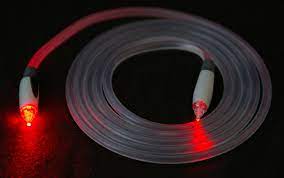What is Optical Technology?

Optical or optical technology is the branch of physics that is related to light or vision, which usually describes the behavior of visible, infrared light, and ultraviolet. Other types of electromagnetic radiation, such as microwaves, X-rays, and radio waves, have comparable properties to light since light is an electromagnetic wave. For instance, optical fiber made out of plastic or glass that carries light signals. An image of optical fibers shown to the right is a kind of wire. A computer can interpret these signals as data (binary), which is an instance of how data can be transferred on the network.
A computer mouse makes use of optical technology; therefore, it is considered an optical device. To determine a mouse direction, it utilizes photodiodes and a light-emitting diode. Then, this enables the computer to move the mouse cursor on the PC display in the right direction. On an opaque surface, an optical mouse can detect the direction of movement easily; hence, it works best on this kind of surface. And an optical mouse can be unable to detect the movement on the surfaces like glass and a mirror, as these kinds of surfaces are not viable to use an optical device. A laser diode is used by newer optical mice to increase movement precision and resolution.
Most optical phenomena may be explained using the classical electromagnetic explanation of light. However, it can be difficult to apply Complete electromagnetic descriptions of light in practice. Generally, practical optics are done with the help of using simplified models. Light is viewed as a bundle of rays that transmit in straight lines and bend as they travel through or reflect off surfaces in geometric optics. As a more thorough description of light, physical optics incorporates wave effects like interference and diffraction. The ray-based model of light was developed initially, followed by the wave model of light, and then the ray-based model of light.
Optical storage devices like Blu-ray, CDs, DVDs make use of optical technology to hold and retrieve data on discs. The device makes use of laser light in order to read information and to write for future retrieval on the disc. There is the fact that the light contains wave-like and particle-like properties, and some incidents are dependent upon this fact. Quantum mechanics are needed to give an explanation of these requirements.
Also, in some computers, optical technology can be used, where instead of electric current, computations are completed with the help of using photons in infrared beams or visible. A computer is known as an optical computer in which this technology is used that can have the ability to greatly increase computational speed. An optical computer that operates at one-tenth the speed of light and processes data at 10 times the rate of today’s computer may be conceivable one day. The optical computing technology is developed by Intel that would substantially reduce energy consumption and improve computer performance.
Furthermore, optical science studies the behavior and properties of light that are relevant to many related disciplines, including medicine, astronomy, photography, and different engineering fields. Practical applications of optics are included: fiber optics, mirrors, lenses, microscopes, telescopes, and lasers. Related to computers, some other examples of optical terms are given below:
- Optical mouse
- Optical reader
- Optical scanner
- Optical carrier
- Optical communications
- Optical disc
- Optical drive
- Optical Character Recognition
- Optical zoom
- Optical drive audio connector
Applications of optical technology
Optics are indiscernible to the functioning of various consumer goods, including cameras, and most people get advantages from contact lenses or eyeglasses. Examples of optical phenomena are mirages and rainbows. For both modern telephony and the Internet, optical communication offers the backbone. Below are discussed some applications of optics:
Human eye
The human eye focuses light onto a layer of photoreceptor cells via the retina. The retina is the back of the eye’s inner lining. The eye’s optical power is provided by light passing through the cornea and then entering the eye. The light then proceeds behind the cornea with the help of fluid; the anterior chamber passes over the pupil. Then, the light moves via the lens, which allows adjustment of focus and focuses the light further. And, then the light in the eye moves via the main body of fluid and reaches the retina.
Photography
The optics of photography, in which electromagnetic radiation is recorded, involves the lenses and the medium. Photographers must consider the shot and the reciprocity of the camera that is summarized by the relation.
Atmospheric optics
The unique optical qualities of the atmosphere cause a wide spectrum of remarkable visual phenomena. The direct result of Rayleigh’s scattering is the blue color of the sky, which led to redirecting much blue color frequency back into the field of the view of the spectator.
